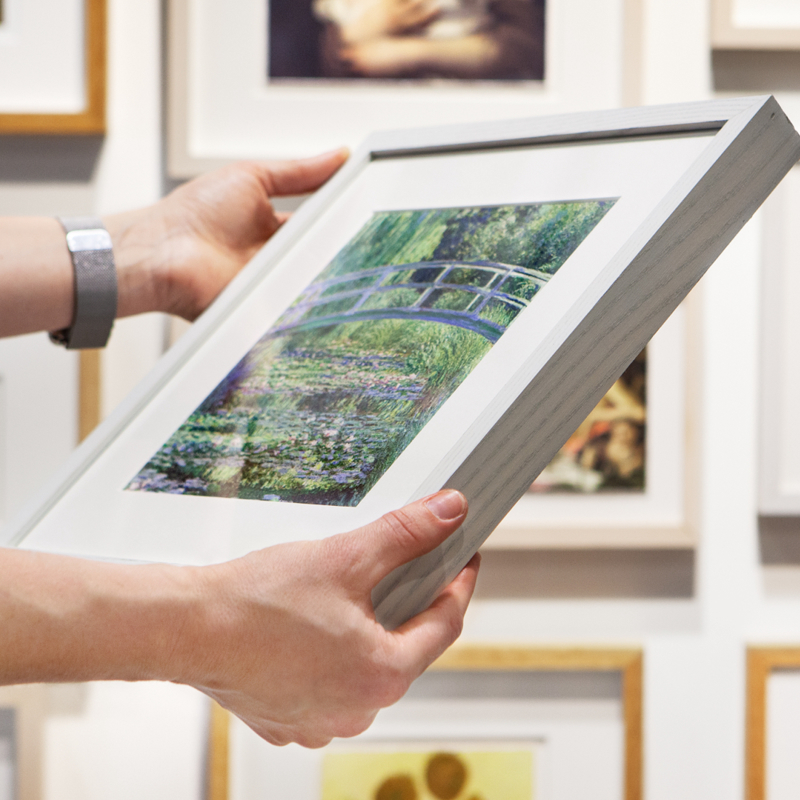Richard Wilson, 'Holt Bridge on the River Dee', before 1762
About the work
Overview
The view is of Holt Bridge, spanning the River Dee, at the point where the river serves as a border between Wales and England. It was painted as a pair with The Valley of the Dee with Chester in the Distance, also in the National Gallery. They are landscapes painted in the spirit of the French neoclassical landscape painter, Claude, who depicted views of the countryside outside Rome, rather than accurate depictions of real views in Cheshire. The village of Holt can be seen on the left and the tower of Farndon church on the right, but the foreground and hills have been changed to make them appear more picturesque and dramatic.
A young man plays a flute, while a reclining woman shades her eyes and gazes up towards the sun; the youth beside her looks in the same direction. The head of another man appears behind them over the brow of the hill.
Key facts
Details
- Full title
- Holt Bridge on the River Dee
- Artist
- Richard Wilson
- Artist dates
- 1713/14 - 1782
- Date made
- before 1762
- Medium and support
- oil on canvas
- Dimensions
- 148.5 × 193 cm
- Acquisition credit
- Bought, 1953
- Inventory number
- NG6196
- Location
- Room 34
- Collection
- Main Collection
- Frame
- 19th-century English Frame
Provenance
Additional information
Text extracted from the ‘Provenance’ section of the catalogue entry in Judy Egerton, ‘National Gallery Catalogues: The British Paintings’, London 2000; for further information, see the full catalogue entry.
Exhibition history
-
2012Loan to Anglesey AbbeyAnglesey Abbey (The National Trust)14 March 2012 - 5 June 2012
-
2014Richard Wilson and the Transformation of European Landscape PaintingYale Center for British Art6 March 2014 - 1 June 2014Amgueddfa Cymru — National Museum Wales5 July 2014 - 26 October 2014
-
2020Masterpieces from the National Gallery, LondonThe National Museum of Western Art18 June 2020 - 18 October 2020The National Museum of Art3 November 2020 - 31 January 2021
-
2021Botticelli to Van Gogh: Masterpieces from the National Gallery, LondonNational Gallery of Australia5 March 2021 - 14 June 2021
Bibliography
-
1821J.P. Neale, Views of the Seats of Noblemen and Gentlemen in England and Wales, Scotland and Ireland: Helmington Hall, London 1821
-
1955The National Gallery, The National Gallery: 1938 - 1954, London 1955
-
1959Davies, Martin, National Gallery Catalogues: British School, 2nd edn (revised), London 1959
-
1973L. Parris, Landscape in Britain, c.1750-1850 (exh. cat. Tate Gallery, 20 November 1973 - 3 February 1974), London 1973
-
1982M. Rosenthal, British Landscape Painting, Oxford 1982
-
1992J.T. Hayes, British Paintings of the Sixteenth through Nineteenth Centuries, Washington 1992
-
1995R. White and J. Pilc, 'Analyses of Paint Media', National Gallery Technical Bulletin, XVI, 1995, pp. 85-95
-
1998J. Egerton, The British School, London 1998
-
2000Egerton, Judy, National Gallery Catalogues: The British Paintings, revised edn, London 2000
-
2000S. Matthews, 'Manipulating the Landscape: Richard Wilson and the Dee Valley', Cheshire History, 40, 2000, pp. 26-30
-
2001
C. Baker and T. Henry, The National Gallery: Complete Illustrated Catalogue, London 2001
Frame
Dating from the end of the eighteenth century to the early nineteenth century, this English frame is in the style of the ‘Carlo Maratta’ frame, named after the Roman artist Carlo Maratta (1625–1713). The frame is made from pinewood and is partially water- and oil-gilt. The back edge is decorated with an acanthus-leaf design and the outward-curving top is adorned with a ribbon-and-stick motif. The deep central hollow is embellished with acanthus leaves and shields. There is cabochon (egg-and-nest) motif near the sight edge.
This is one of a pair of frames that were crafted for two paintings by Richard Wilson.
About this record
If you know more about this painting or have spotted an error, please contact us. Please note that exhibition histories are listed from 2009 onwards. Bibliographies may not be complete; more comprehensive information is available in the National Gallery Library.


